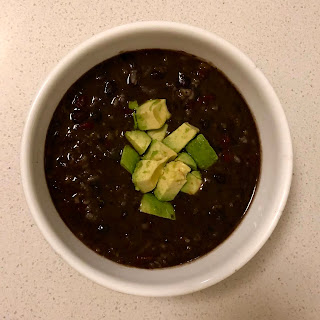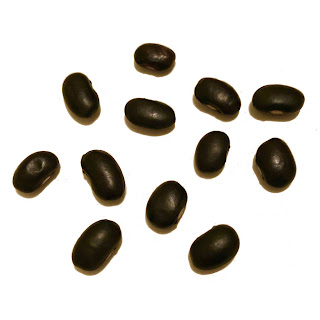sopa negra
Though there's a huge variety of cuisine around the world, most cultures love slurping down some form of a bean soup. From Japanese adzuki bean soup in Asia to Moroccan white bean soup in Africa, from ancient Grecian fassoulada to today's American chilis, bean soup is ubiquitous across regions and throughout culinary history [1]. We can't muse on bean soup, however, without recognizing one of the most popular recipes: black bean soup.
I think black beans make a particularly interesting soup because of their striking dark color. We're taught growing up that colorful plates are the most nutritious, and rarely do we eat black foods. Yet black bean soup's richness in protein, fiber, vitamin B, and more makes it a compelling counterexample to the rule. It's also highly economical, as the liquid used to cook the beans becomes a key component of the dish itself. For these reasons, throughout Latin America, locals enjoy many different preparations of black bean soup. But the dish is becoming a delicacy as well; nowadays, you can find black bean soup recipes on the prestigious pages of a James Beard cookbook or on the menu of a gourmet restaurant.
In this post, however, I'm focusing on a traditional recipe from Costa Rica, locally called "Sopa Negra." From what I've gleaned reading recipes written by locals, Costa Ricans claim that their "Sopa Negra" is the original black bean soup despite it's popularity throughout the region. They also claim that Spanish colonists originally rejected eating beans, but after quickly running out of food supply, were chowing down on "Sopa Negra" too [2]. This certainly seems to be the case, as black bean soups have eventually become part of American and Spanish fine dining. But I wonder if these new iterations, which often add classic French ingredients like butter and wine to the basic recipe, are actually any more delicious. After cooking this unadorned version, I find it hard to believe that the traditional recipes can be topped.
Recipe

Ingredients
1 lb black beans
1 red bell pepper, finely chopped
1 green bell pepper, finely chopped
1 large onion, finely chopped
4 cloves garlic, chopped
I think black beans make a particularly interesting soup because of their striking dark color. We're taught growing up that colorful plates are the most nutritious, and rarely do we eat black foods. Yet black bean soup's richness in protein, fiber, vitamin B, and more makes it a compelling counterexample to the rule. It's also highly economical, as the liquid used to cook the beans becomes a key component of the dish itself. For these reasons, throughout Latin America, locals enjoy many different preparations of black bean soup. But the dish is becoming a delicacy as well; nowadays, you can find black bean soup recipes on the prestigious pages of a James Beard cookbook or on the menu of a gourmet restaurant.
In this post, however, I'm focusing on a traditional recipe from Costa Rica, locally called "Sopa Negra." From what I've gleaned reading recipes written by locals, Costa Ricans claim that their "Sopa Negra" is the original black bean soup despite it's popularity throughout the region. They also claim that Spanish colonists originally rejected eating beans, but after quickly running out of food supply, were chowing down on "Sopa Negra" too [2]. This certainly seems to be the case, as black bean soups have eventually become part of American and Spanish fine dining. But I wonder if these new iterations, which often add classic French ingredients like butter and wine to the basic recipe, are actually any more delicious. After cooking this unadorned version, I find it hard to believe that the traditional recipes can be topped.
Recipe

Ingredients
1 lb black beans
1 red bell pepper, finely chopped
1 green bell pepper, finely chopped
1 large onion, finely chopped
4 cloves garlic, chopped
¼ cup chopped cilantro
2 tablespoons oregano
2 tablespoons oil
(Optional) Avocados or eggs, for topping*
Step 1
Add the chopped bell peppers and onions to a pot (stovetop or Instant Pot) with oil. Saute for about 5 minutes, until the onions are translucent.
Step 2
Add the garlic, cilantro, and oregano to the pot and saute for another minute or so.
Step 3
Add the beans and 4 cups of water to the pot. Follow the cooking instructions in the bean cooking guide table, depending on if you soaked your beans and what you're cooking in.
Step 4
When the beans are soft, scoop 2 cups of beans and 1 cup of liquid from the pot into a blender. Blend the mixture until it's smooth and pour it back into the pot.
Step 5
If you're on the stovetop, cook the soup for 30 more minutes. If you're using the Instant Pot, reseal and cook on Manual for 10 more minutes.
Step 6
If you are adding eggs, poach your desired amount of eggs in the soup while it's still hot. Otherwise, remove from heat and top with avocados, or just enjoy it plain!
*Traditionally, Costa Ricans poach eggs in the soup broth. You can also use hard boiled eggs if you don't want to attempt poaching. I used avocados for a vegan option that adds a similar soft fattiness.
[1] Rumble, Victoria R. Soup Through the Ages: a Culinary History with Period Recipes. McFarland & Company, Inc., 2009.
[2] “La Sopa Negra De Costa Rica, Una Exquisita Tradición.” La Choza De Laurel, 28 Mar. 2017, lachozadelaurel.com/la-sopa-negra-de-costa-rica/.2 tablespoons oregano
2 tablespoons oil
(Optional) Avocados or eggs, for topping*
Step 1
Add the chopped bell peppers and onions to a pot (stovetop or Instant Pot) with oil. Saute for about 5 minutes, until the onions are translucent.
Step 2
Add the garlic, cilantro, and oregano to the pot and saute for another minute or so.
Step 3
Add the beans and 4 cups of water to the pot. Follow the cooking instructions in the bean cooking guide table, depending on if you soaked your beans and what you're cooking in.
Step 4
When the beans are soft, scoop 2 cups of beans and 1 cup of liquid from the pot into a blender. Blend the mixture until it's smooth and pour it back into the pot.
Step 5
If you're on the stovetop, cook the soup for 30 more minutes. If you're using the Instant Pot, reseal and cook on Manual for 10 more minutes.
Step 6
If you are adding eggs, poach your desired amount of eggs in the soup while it's still hot. Otherwise, remove from heat and top with avocados, or just enjoy it plain!
*Traditionally, Costa Ricans poach eggs in the soup broth. You can also use hard boiled eggs if you don't want to attempt poaching. I used avocados for a vegan option that adds a similar soft fattiness.


Comments
Post a Comment